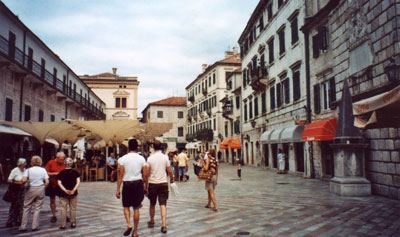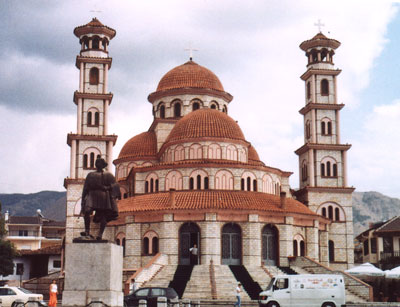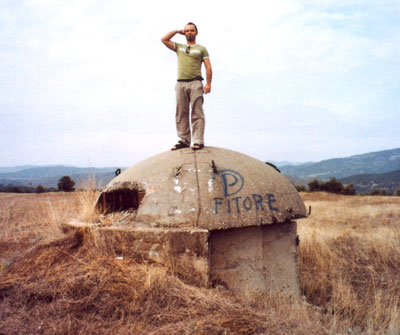A five-country tour of the Balkans
by Claus Hirsch, New York City, NY
In October 2009 I embarked on a five-country guided tour of the Balkans. Starting in Montenegro and ending in Serbia, the tour was spread out over a period of three weeks. During this time, the tour operator, Original World (Mill Valley, CA; 888/367-6147, www.originalworld.com), arranged for several groups, varying in size from three to eleven, to hop on or off the different “modules” that comprised the total experience.
General observations
Each of the five countries we visited can fairly be classified as a developing country, yet each has a long history under different political systems and religious institutions dating back thousands of years. We saw impressive stone churches and some mosques in Montenegro, Albania, Macedonia, Kosovo and Serbia. Many of these old churches still are functioning on a daily basis, and some of the better-known ones house frescoes a thousand years old or more.
We also visited several finely preserved monasteries dating back hundreds of years. In each case, several very tall, bearded monks were in residence and there to greet visitors. The Orthodox religion appears to be alive and well in the Balkans, yet it and the local brand of Islam both seem to be far more tolerant of women’s dress codes than their counterparts are in the Middle East.
Food is one of the other common denominators in this region, with the influence of Greece, Italy and Turkey evident in the dishes offered to visitors. I was pleasantly surprised by the tasty foods available in local restaurants, in particular, well-prepared fish, aubergine (eggplant) and wonderful fresh tomatoes and other local produce.
Unlike in places like Norway and Holland, where virtually everyone speaks English, in this region that is not the case. Still, many schoolchildren now take English as a second language, and one can always find a hotel or restaurant employee who knows enough English to communicate with visitors.
The road system, generally, was acceptable — even if not up to American or Western European standards — making it possible to cover a fair amount of distance daily (except in the very mountainous areas). But many of the roads, although paved, were only two lanes wide. And there was always the disturbing tendency of many of the locals to tailgate and pass while heading into a curve, an unnerving practice followed even by otherwise polite and well-informed locals.
Hotel accommodations varied widely in quality but generally were good. If the room itself was comfortable and nicely furnished, the problem (if there was one) inevitably was in the bathroom in the form of showers lacking curtains or protective doors or offering low water pressure. But these were minor complaints. After all, I realized this region still is gearing up for Western travelers, and we were there to see the sights and experience the local culture.
We had well-informed and enthusiastic guides throughout the tour.
The land-only cost of the 19-day Balkans tour, covering Albania, Macedonia, Kosovo and Serbia, was $5,055, including all breakfasts and nearly all dinners. The short, pre-tour extension to Montenegro cost an additional $1,275 for a total of $6,330, exclusive of airfares and single supplements. It should be noted that this was about 29% more than the advertised catalog price of $4,925, which was for a minimum of six travelers. We had three travelers on leg one, 11 on leg two and five on leg three.
Montenegro
Montenegro, formerly part of Yugoslavia and then part of the merged nation of Serbia and Montenegro, conjures up images of romance and intrigue. The name, itself, meaning Black Mountain, has a certain ring to it. (Locally, the now-independent country is known as Crna Gora.)
It is hard to imagine that at one time in history this country of only about 680,000 residents provided many of the royals in Europe’s ruling houses. Today’s Montenegro still graphically shows the influence of its past rulers.
If Kotor, the port city where we spent two days, looks much like Venice, there is a good reason: the Venetians ruled this area for nearly 400 years, until 1797. In Kotor one sees Venice everywhere — in the old stone houses, the palazzos dating back several centuries, the well-worn cobblestone streets, the narrow alleys, the small shops (selling everything from souvenirs to baked goods to clothing) and the piazzas.
This really is a walker’s city, and the steep surrounding mountains and nearby bay all add to its glamour.
While in Kotor, we visited the small but well-stocked Maritime Museum. This building, formerly the 18th-century palace of the Grgurina family, houses a collection of swords and old rifles along with metal sculptures, painted portraits, furniture and various other reminders of its royal past.
We actually saw more concrete evidence of Montenegro’s royal past when we left Kotor for the nearby town of Cetinje, the former royal capital.
Cetinje is a small, clean and subdued town situated away from cruise ship routes and devoid of crowded streets. We visited the Palace of King Nikola I, now a museum housing a large collection of royal medals, period furniture (much of it frilly and pink), royal portraits and the ubiquitous collection of rifles and swords, many with exquisite inlays.
After a brief stopover in Cetinje, it was on to the town of Budva, where we stayed for one night at the five-star Avala Hotel. There we sampled the good local red wine known as Vranac and ate from an excellent buffet of mildly spiced and tender lamb and other meats and a wide selection of tasty salads and desserts. The next day we drove on to Albania.
Albania
Anyone visiting the ancient country of Albania for the first time will most likely be struck by its seeming incongruities. It is a country which stagnated for almost 50 years under Communist rule following World War II, when precious resources were spent on building bomb shelters while road systems and other public projects were neglected. Today, several hundred thousand of these mushroom-shaped shelters still dot the landscape, without anyone quite knowing what to do with the indestructible steel-reinforced concrete structures.
But Mercedes cars abound! When our local guide told us that Albania has more Mercedes cars per capita than any country in the world, I was skeptical. After spending 10 days in the country, I believed him.
Cynics contend that a major reason for the ubiquitous prestige cars is that most Mercedes stolen in Western Europe end up in Albania — a possible explanation of why one of the poorest countries in Europe, with a per capita annual income of only around $4,000, has so many luxury cars.
Most of the roads are paved, but a great many have only two lanes, making for slow traffic and the tendencies toward tailgating and dangerous passing that we also witnessed in Montenegro. And despite the low incomes of the people, TV satellite dishes are everywhere also, and gasoline sells for about $5 per gallon.
For an ancient country that was under foreign domination for much of its history, it was not surprising to see outside influences in both Albania’s cuisine and monuments. Turkish influence could be seen in much of the cooking, as the Ottoman Empire ruled here for hundreds of years.
But the local heroes who were successful in fending off the Ottoman armies also receive their due. Most noteworthy in this category is Skanderbeg, who triumphed over the Ottoman armies more than 20 times in the 15th century. This national hero has an impressive museum and castle in the town of Krujë. Part of the Skanderbeg complex includes an ethnographic museum featuring houses furnished with period furniture.
Tirana and beyond
Our starting point in Albania, however, was the capital, Tirana. The city, itself, with many drab apartment buildings from the long postwar period of Communist rule, did not impress like other major Western European capitals, but there is an excellent National Historical Museum with good displays of arms, military uniforms, period photos from the 18th and 19th centuries and exhibits of prehistoric periods, in addition to art museums and some unusual monuments designed by the late dictator’s daughter. Attempts to “dress up” the many dreary apartment blocks have taken the form of innovative splashes of color.
Tirana also has its share of restaurants, serving a broad selection of veal, chicken, pasta and tasty, fresh produce. Here, as elsewhere in the western Balkans, I saw evidence of the influence of neighboring Greece, Turkey and Italy.
From Tirana our group drove by minivan to Krujë, the earlier-mentioned site of the Skanderbeg Museum complex, and then to the town of Gjirokastra, a UNESCO World Heritage Site. The designation seems well deserved for this unique place, which seemed unchanged from what it must have been like in the 16th century.
In this very hilly and cobblestoned town, we toured the inside of an unoccupied mansion that has been in the same family for 11 generations. (The owner is seeking funding to restore it.) We also visited the impressive Silver Fortress, dating to the fourth century AD.
In Saranda, the next town on our itinerary, we saw the scenic Bay of Saranda and many attractive modern villas and apartment buildings that house wealthy investors from Western Europe on their holidays abroad. We stayed at the modern Hotel Brilant, with balconies overlooking the bay. Dinner at a nearby restaurant, featuring pasta, an ample green salad and a large carafe of good imported wine, came to about $10.
Also included on our Albania tour was the archaeological site of Apollonia. The site took us back to Roman times with its nicely reconstructed arches, old monastery and amphitheater.
In Durrës, we had an outstanding multicourse fish dinner at the Virgin Restorant by the Adriatic Sea.
From Berat we began the third leg of our multicountry tour. This was the ending point for half the group. (A fuller account of the Albania tour with this same operator appeared in the July ’08 issue of ITN, page 38.)
Macedonia
Entering the town of Ohrid in Macedonia was a thrilling experience. This clean, historic town includes spiffy 18th-century mansions, cobblestone streets, a reconstructed Roman amphitheater and several historic churches.
I also enjoyed a visit to the 11th-century Monastery of St. John Bigorski complex near Ohrid. This beautifully maintained group of buildings is set in an idyllic rural area and, like some of the churches in the town of Ohrid, has many ancient mosaics.
In Ohrid we stayed in well-furnished suites at the tastefully decorated Hotel Vila Sofija. Breakfast was at the hotel, of course, but we had a magnificent fish dinner at the nearby Restaurant Sveta Sofija, with a superb trout from Lake Ohrid. The meal, proudly served by a professional wait staff, was one of the highlights of our tour.
From Ohrid we moved on to Tetovo for a brief stop in this small town, which included a visit to a local mosque. Then it was on to the capital city of Skopje. This is an attractive city featuring many stone houses with red-tile roofs, a bazaar next to our hotel, a 15th-century stone bridge crossing the Vardar River and, of course, a fortress.
During its 2,000-year history, Skopje had been under Bulgarian, Byzantine, Serbian and Ottoman domination before becoming part of the former Yugoslavia. Now it is the independent “former Yugoslav Republic of Macedonia.” Much of the city was destroyed in a 1963 earthquake, but it appears to have been rebuilt very nicely.
Kosovo
We made visits to the newly independent country of Kosovo from our base in Macedonia. Over a two-day period we experienced what it was like to be in an area with Kosovo Force troops of several nations very much in evidence in towns and on the highways. Still, driving to Kosovo for the first time was a peaceful experience, with the beautifully forested area and well-paved highway leading into the area, belying the country’s troubled history over the recent past.
At various stages of our Kosovo visit, we saw German tanks, armored vehicles and soldiers from Slovakia, Italy and Sweden. There also were monuments to the soldiers who fought against the Serbs and even a few handwritten signs saying “Thank you, USA.”
A visit to the town of Prizren and a lunch in a local restaurant gave the impression that the people are leading normal lives, despite a very high unemployment rate. The town’s youthful population was everywhere and anyone over the age of 40 seemed a bit out of place.
Prizren has its share of local shops with fine, handcrafted jewelry but otherwise seems unprepared for much tourist business — either in the form of acceptable lodgings or local handicrafts.
We saw the capital city of Pristina only at night, but we did see the famous battlefield where the Battle of Kosovo was fought in 1389 between Serbia and the Ottomans, which the late Serbian dictator Slobodan Miloševic´ used as a rallying cry in the recent Yugoslav Wars.
Serbia
Serbia was a pleasant surprise for this first-time visitor. In this country of 7.5 million, I saw attractively forested mountain areas, well-maintained monasteries and a classic European capital city in the form of Belgrade.
We spent only a little over a day in Belgrade — far too short a period to appreciate the grandeur of its 19th-century architecture, beautiful parks, a well-restored fortress and clean and attractive pedestrian-only downtown streets.
We could not visit Belgrade’s National Museum because the institution, boasting an impressive collection of oils, including works of the French impressionists, has been closed for close to 10 years, a situation some locals think is a result of politics. But we could and did see free exhibitions featuring Serbian artists.
On our second day in Serbia we ventured out to the rural area of Zlatibor, the site of an outdoor museum featuring relocated farmhouses of 200 years ago. It was a refreshing change from urban Serbia — set in a mountainous area 3,000-5,000 feet high with a plentiful supply of fir trees — and it compared well with similar museums I had visited in Scandinavia and the Baltics. We even spent a night in wooden cabins, complete with modern amenities, within the village of Sirogojno.
On our final day in the Balkans we returned to Belgrade and had a delightful farewell dinner in the Bohemian section of the city. Here, on narrow, cobblestone streets, there is a large assemblage of handicraft sellers and colorful bistros serving the local fare.
Our dinner was accompanied by live music from a band of happy troubadours — a fitting end to a Balkan adventure.



